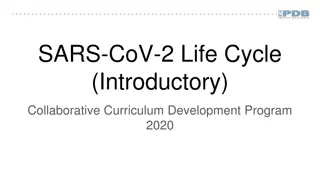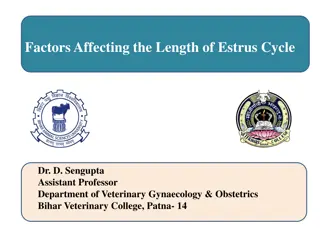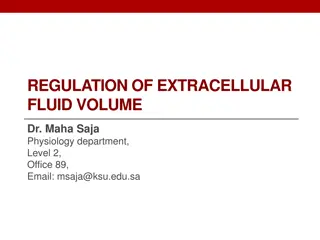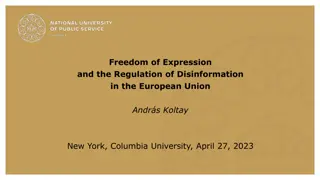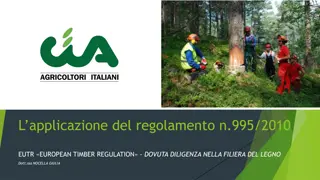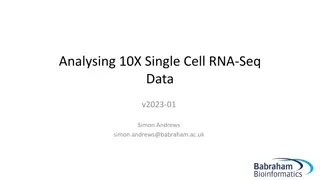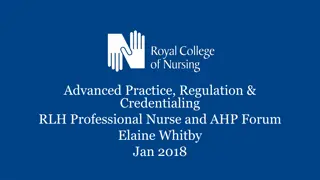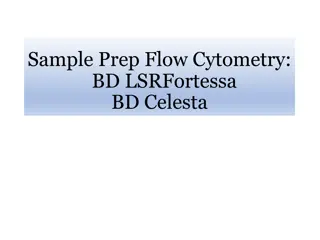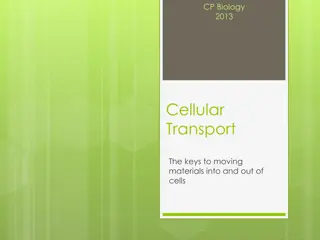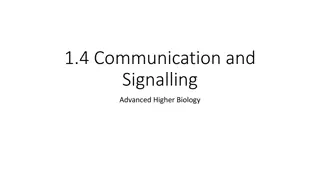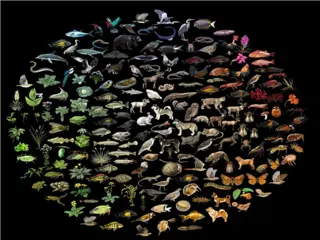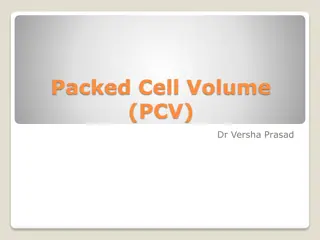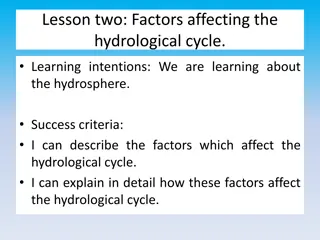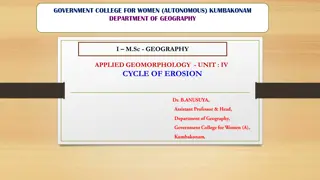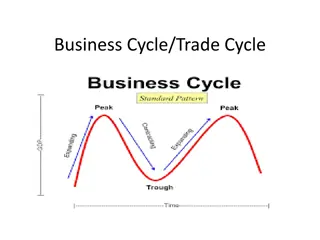Regulation of the Cell Cycle: A Comprehensive Overview
Variation in cell cycle length in humans, controlled by internal and external mechanisms, with special proteins and checkpoint systems ensuring proper progression. External events trigger initiation and inhibition of cell division, while internal checkpoints maintain genetic integrity and chromosome duplication, critical for accurate cell division. The G1 checkpoint assesses favorable conditions for cell division to proceed, influenced by factors like growth factors and DNA damage. Understanding these regulatory processes is essential for maintaining cell cycle harmony and preventing mutations.
Download Presentation

Please find below an Image/Link to download the presentation.
The content on the website is provided AS IS for your information and personal use only. It may not be sold, licensed, or shared on other websites without obtaining consent from the author. Download presentation by click this link. If you encounter any issues during the download, it is possible that the publisher has removed the file from their server.
E N D
Presentation Transcript
Variation of length of cell cycle In humans, the frequency of cell turnover varies Early embryonic development (Few hours ) Epithelial cells (2-5 days) Specialized cells (cortical neurons or cardiac muscle cells) spends entire life time in G0 phase Invitro culture condition Mammalian cells divide fast in culture medium (optimal growing condition), so length of the cycle is about 24 hours (G1 phase 9 hours, S phase 10 hours, G2 phase 3.5 hour, M phase 0.5 hour) The timing of events in the cell cycle is controlled by mechanisms that are both internal and external to the cell
Cells use special proteins and checkpoint signaling systems to ensure that the cell cycle progresses properly Regulation of the Cell Cycle by External Events Initiation and inhibition of cell division are triggered by events external to the cell. Begin the replication process. Event of cell death of a nearby cell or release of growth-promoting hormones, such as human growth hormone (HGH). A lack of HGH can inhibit cell division : Dwarfism Too much HGH can result: Gigantism When the size of the cell grows, it divides to decrease the surface-to-volume ratio For an event to occur the cell must receive the signal, thereafter series of events occurs within the cell and further it proceeds into interphase. Moving forward from this initiation point, every parameter required during each cell cycle phase must be met or the cycle cannot progress.
Regulation at Internal Checkpoints It is highly required that the daughter cells produced should receive be exact duplicates genetic material of the parent cell (daughter exact duplicate of mother). Mistakes in the duplication or distribution of the chromosomes lead to mutations that may be passed forward to every new cell produced from an abnormal cell. To prevent a compromised cell from continuing to divide, there are internal control mechanisms that operate at cell cycle checkpoints. The cell cycle is controlled at three checkpoints. The integrity of the DNA is assessed at the G1checkpoint. Proper chromosome duplication is assessed at the G2checkpoint. Attachment of each kinetochore to a spindle fiber is assessed at the M checkpoint
The G1 Checkpoint The G1 checkpoint determines whether all conditions are favorable for cell division to proceed. External influences, such as growth factors, play a large role in carrying the cell past the G1 checkpoint. Adequate cell reserves, cell size, check for genomic DNA damage at the G1 checkpoint. A cell that does not meet all the requirements will not be allowed to progress into the S phase. The cell can halt the cycle and remedial measures to be taken for the problematic condition, or The cell can advance into G0 and await further signals when conditions improve
The G2Checkpoint The G2checkpoint blocks entry into the mitotic phase if certain conditions are not met. As at the G1checkpoint, The assessment of cell size and protein reserves takes place. Ensuring that all the chromosomes have been replicated and the replicated DNA are not damaged. When the checkpoint mechanisms detect problems with the DNA, the cell cycle is halted, and the cell attempts to either complete DNA replication or repair the damaged DNA.
The M Checkpoint The M checkpoint occurs near the end of the metaphase stage of karyokinesis. The M checkpoint is also known as the spindle checkpoint, because it determines whether all the sister chromatids are correctly attached to the spindle microtubules. Because the separation of the sister chromatids during anaphase is an irreversible step, the cycle will not proceed until the kinetochores of each pair of sister chromatids are firmly anchored to at least two spindle fibers arising from opposite poles of the cell.
Regulator Molecules of the Cell Cycle In addition to the internally controlled checkpoints Two groups of intracellular molecules that regulate the cell cycle. These regulatory molecules either Promote progress of the cell to the next phase (positive regulation) or Halt the cycle (negative regulation). Regulator molecules may act individually, or they can influence the activity or production of other regulatory proteins. Therefore, the failure of a single regulator may have almost no effect on the cell cycle, especially if more than one mechanism controls the same event. Conversely, the effect of a deficient or non-functioning regulator can be wide-ranging and possibly fatal to the cell if multiple processes are affected
Positive Regulation of the Cell Cycle Two groups of proteins, called cyclins and cyclin-dependent kinases (Cdks), are responsible for the progress of the cell through the various checkpoints. The levels of the four cyclin proteins (Cyclin A, Cyclin D, Cyclin E, Cyclin B) fluctuate throughout the cell cycle in a predictable pattern. Increases in the concentration of cyclin proteins are triggered by both external and internal signals. After the cell moves to the next stage of the cell cycle, the cyclins that were active in the previous stage are degraded. The concentrations of cyclin proteins change throughout the cell cycle. There is a direct correlation between cyclin accumulation and the three major cell cycle checkpoints. Also note the sharp decline of cyclin levels following each checkpoint (the transition between phases of the cell cycle), as cyclin is degraded by cytoplasmic enzymes.
Cyclins regulate the cell cycle only when they are tightly bound to Cyclin dependent kinase ( Cdks). Cdks are protein kinases. To be fully active, the Cdk/cyclin complex must also be phosphorylated in specific locations. Cdks are enzymes that phosphorylate other proteins. Phosphorylation activates the protein by changing its shape. The proteins phosphorylated by Cdks are involved in advancing the cell to the next phase. The levels of Cdk proteins are relatively stable throughout the cell cycle; however, the concentrations of cyclin fluctuate and determine when Cdk/cyclin complexes form. The different cyclins and Cdks bind at specific points in the cell cycle and thus regulate different checkpoints. Cyclin-dependent kinases (Cdks) are protein kinases that, when fully activated, can phosphorylate and thus activate other proteins that advance the cell cycle past a checkpoint. To become fully activated, a Cdk must bind to a cyclin protein and then be phosphorylated by another kinase.
Chromosome Cohesion; G2phase and the beginning of mitosis are denoted by a 4-N DNA content. Following DNA replication and prior to cell division (cytokinesis), cells must maintain the integrity and proximity of the recently duplicated chromosomes (sister chromatids). Cohesin and condensin have distinct structure and function and have chromosomal ATPases of the structural maintenance of chromosomes (SMC) protein family. Cohesin might encircle two sister chromatids to promote their cohesion, whereas condensin might stabilize supercoiled DNA loops on a single chromatid to promote its condensation. Before segregation, sister chromatids are held together or glued by a multiprotein complex called Cohesion. The cohesin complex ensures that sister chromatids are recognized and properly aligned during metaphase. Once aligned, segregation happens following proteolytic cleavage of cohesin components. Cohesin is composed of four subunits, Smc1/3 and Scc1/3. Smc1 and Smc3 heterodimerize in a head-to-head, tail-to-tail fashion to form a ring structure in an ATP-dependent manner. The Scc1 subunit contacts both Smc1 and 3 and likely stabilizes the ring structure. Models suggest that the cohesin ring has a diameter of approximately 50 nm, which can two sister chromatids. Cohesin is envisioned to function by binding and encircling DNA, thereby gluing sister chromatids together until released.
Schematic of cohesin structure in mice and humans. (A) The cohesin complex comprises four subunits, Smc1 , Smc3, Stag3 and Rec8, and surrounds sister chromatids in a ring- like protein structure in mice (B) and humans (C). Int. J. Mol. Sci. 2017, 18(7), 1578; https://doi.org/10.3390/ijms18071578
Sororin is a phosphoprotein master regulator of sister chromatid cohesion (SCC). its dynamic localization and function are regulated by protein kinases, such as Cdk1/cyclin B and Erk2. ESCO1 (Establishment Of Sister Chromatid Cohesion N-Acetyltransferase 1) ESCO2 (Establishment Of Sister Chromatid Cohesion N-Acetyltransferase 2) Pololike kinasi1 Aurora B, a member of the Aurora family of serine/threonine protein kinases, is a key player in chromosome segregation Condensins are large protein complexes that play a central role in chromosome segregation during mitosis and meiosis Separase, also known as separin, is a cysteine protease responsible for triggering anaphase by hydrolysing cohesion Wings Apart-Like Protein Homolog (WAPL) is a key regulator of the Cohesin complex which mediates sister chromatid cohesion. assembly and Genes and Development, 2008, 22, 3089-3114
Cohesin loading begins in telophase. During DNA replication, a fraction of cohesin is acetylated and binds to Sororin making it resistant to WAPL and able to hold sister chromatids together. This is crucial for the maintenance of sister chromatid cohesion because onse the sister chromatids are separated, cohesion cannot be reestablished. When a cell enters mitosis, Sororin is phosphorylated causing it to dissociate from cohesin meaning WAPL can remove cohesin from the DNA. Sister chromatid cohesion is therefore maintained at the centromeres where it is required for mitosis but lost on the arms. This removal of cohesin is known as the Prophase Pathway and results in the X-shape sister chromatids observed in chromosome spreads.









